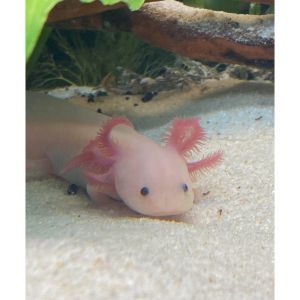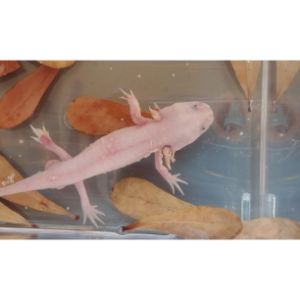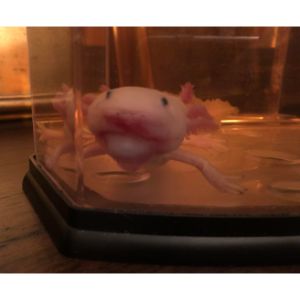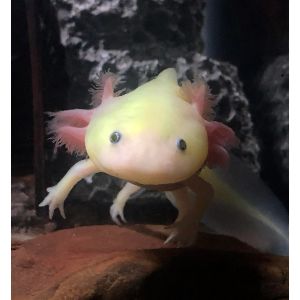Axolotls are widely famous as pets, but it’s not uncommon for them to nip or bite. So, do Axolotls bite?
Generally, two primary explanations exist for why an axolotl might engage in biting behavior. Initially, if they view you as a threat, they may opt to bite in self-defense.
Secondly, during hand-feeding, there is a chance that the Axolotl may inadvertently bite your finger instead of the intended food.
It is essential to mention that while feeding, many axolotl species typically nibble on your fingers, resulting in a tingling sensation rather than inflicting pain through their bites.
Read on to learn more about how an Axolotl bite feels, which parts they typically bite, and what steps to take if you get bitten.
Before you scroll further down this guide, check out these other animal-related articles: Axolotl Shedding: What To Do And Why and Coyote Bite Force: How to Measure It and What It Means.
Why Do Axolotls Bite? Do All Axolotl Species Bite?

Typically, there are two main reasons why an axolotl may bite you. Firstly, if they perceive you as a threat, they might resort to biting as a defensive measure.
Secondly, while hand-feeding, there is a possibility that the Axolotl might mistakenly bite your finger instead of the intended food you’re offering.
It’s worth noting that most axolotl species tend to nibble on your fingers during feeding, which often produces a tingling sensation rather than a painful bite.
The Defense Mechanism
Axolotls may feel threatened in certain situations, leading them to bite in self-defense.
However, such instances are rare with axolotls. While they possess small, sharp teeth that can cause some discomfort, the pain level is typically minimal.
It’s advisable to allow the Axolotl to become familiar with your presence to foster a better relationship with your Axolotl and minimize the chances of biting.
Spend time near the Axolotl’s habitat, gradually introducing your hand and allowing the Axolotl to approach you without feeling afraid.
By establishing trust and familiarity, the Axolotl is less likely to perceive you as a threat and exhibit defensive behaviors such as biting.
Mistake Your Finger Or Hand For Food

The second common reason for being bitten by an axolotl is related to feeding.
When attempting to hand-feed your Axolotl, there is a chance that they might mistake your hand for food and unintentionally bite you.
If you find yourself in this situation, it’s essential to remain calm and avoid shaking your hand forcefully to make the Axolotl let go.
Doing so could potentially harm the Axolotl. Instead, maintain a steady and composed demeanor, allowing the Axolotl to release its grip naturally.
With patience, the Axolotl will eventually let go, and you can safely remove your hand without causing harm to either yourself or the Axolotl.
Does It Hurt When An Axolotl Bites?

Axolotl bites are generally not known to cause significant pain. Even larger axolotls are often hand-fed without causing any discomfort to their owners.
These fascinating creatures are known to bite any finger within proximity readily, but their bites are typically gentle and do not result in significant pain or harm.
Handling axolotls with care and respect is essential, ensuring that you and the Axolotl are comfortable during feeding or interaction sessions.
Does Axolotl Bite People? Do Axolotls Bite Their Owners?

Axolotls display territorial behavior and may bite other axolotls that invade their space or cause annoyance.
During feeding, they may nip at their owner’s fingers, mistaking them for food.
While axolotls can recognize their owners and respond to human hand signals, it’s important to note that they may still bite their handlers on occasion.
Understanding the instincts and behaviors of axolotls is crucial when interacting with them.
Awareness of their territorial nature and the potential for nipping or biting can help handlers take appropriate precautions and minimize potential risks.
Do Axolotls Have Sharp Teeth?

Axolotl teeth are not sharp or prominent like those of frogs or salamanders.
Due to their small size and lack of bulging or protruding edges, their teeth may not be easily visible.
Axolotls have a cartilaginous skeleton that doesn’t fully calcify even in adulthood.
Their jaw structure resembles that of fish, and they have small, fine teeth on their upper and lower jaws, similar to frogs and toads.
However, the bite intensity of axolotls is not typically strong enough to rupture human skin.
Their teeth are primarily for grasping and puncturing their food rather than causing harm to humans.
Handling axolotls with care and respect is essential, but their bites should not cause significant pain or injury to humans.
What To Do When Axolotl Bites You?

It is crucial to remain calm and composed if an axolotl bites your finger.
While it is a natural reflex to want to shake your hand to free yourself, it is important to resist that urge.
Shaking your hand can potentially harm the Axolotl. Instead, keep your hand steady and avoid sudden movements.
You can try to calm the Axolotl by gently stroking it or simply waiting patiently.
In most cases, the Axolotl will release its grip quite quickly once it realizes that your finger is not its regular food.
Their nibbling behavior is often a result of confusion.
By maintaining your calm demeanor; you allow the Axolotl to recognize the mistake and let go of your finger without causing any harm to either party.
Are Axolotls Aggressive?

Axolotls are territorial amphibians, and it is generally recommended not to keep them in aquariums with other species.
They can exhibit aggression towards tank mates, including smaller axolotls, perceiving them as potential prey.
Furthermore, axolotls are fragile creatures, and larger fish have the potential to bite and damage their gills, which can impair their ability to breathe correctly.
That is why it is advisable to keep axolotls in a separate tank or a species-specific setup that meets their specific requirements for a safe and stress-free environment.
Providing an appropriate habitat for axolotls free from potential aggression or harm from other species helps ensure their well-being and allows them to thrive in a suitable environment.
Is It Safe To Touch Axolotl?

Axolotls should be handled with great care as they have delicate and soft tissues.
Unlike frogs, toads, and salamanders, axolotls do not possess toxic secretions or poisonous properties on their bodies.
Their skin is permeable, and they have a significant amount of cartilage in their bodies, which makes them more susceptible to injury.
Rough handling or excessive pressure can damage their internal organs and overall health.
It is generally best to avoid handling axolotls unless necessary, such as during a health check or an emergency.
Minimizing unnecessary handling helps reduce the risk of accidental injury and allows axolotls to thrive in their aquatic environment without undue stress.
Is Axolotl Dangerous To Humans?

Axolotls are not a significant threat to humans, and their bites are generally incapable of causing harm.
Their small and gentle bites are not typically painful or dangerous to humans.
However, it is essential to note that territorial behavior can arise when axolotls are housed together with other species or even with other axolotls in a shared tank.
In such situations, conflicts may occur, and axolotls may exhibit aggression towards one another.
That can involve biting or nipping at the body parts of their tank mates as they establish dominance or defend their territory.
It is advisable to provide appropriate tank setups and separate individuals that display aggressive behavior to ensure the well-being of axolotls and other aquatic species.
Creating a harmonious and suitable environment for axolotls helps minimize conflicts and ensures the safety and welfare of all tank inhabitants.
How Do I Stop My Axolotl From Biting Each Other?

Feeding axolotls adequately and ensuring they receive enough food can help minimize nipping or aggressive behavior caused by hunger or competition for resources.
It’s essential to provide sufficient food for all the axolotls in the tank to avoid any unnecessary conflicts.
Additionally, during feeding time, it is beneficial to maintain a safe distance between axolotls to prevent them from competing aggressively for food.
That can help reduce stress and potential nipping incidents.
Regarding keeping opposite-sex axolotls together, it is generally best to avoid doing so unless you have specific breeding intentions.
Axolotls do not have a defined social hierarchy, and keeping males and females together can lead to aggressive behavior and potential harm.
If you intend to breed axolotls, it is essential to research proper breeding practices and provide a separate breeding setup to ensure the well-being of both the adults and any resulting offspring.
FAQs About Axolotls

Are axolotls friendly?
Axolotls are generally peaceful and gentle creatures.
While they may not exhibit typical pet-like behaviors associated with friendliness, such as seeking physical affection, they can become accustomed to their owners’ presence and recognize them.
With proper care, handling, and a consistent routine, axolotls can develop trust and familiarity with their owners.
It’s important to remember that each Axolotl has its unique personality, and some may be more interactive or curious than others.
Is it OK to touch Axolotl?
It is generally best to minimize direct contact with axolotls unless necessary.
Axolotls have delicate and sensitive skin, which can be easily damaged or irritated.
Their skin is also permeable, meaning that substances on our hands, such as lotions, oils, or chemicals, can be absorbed by the Axolotl and harm them.
Suppose you need to handle an axolotl for specific reasons, such as transferring them to a different tank or providing necessary care.
In that case, ensuring your hands are thoroughly clean and free from harmful substances is essential.
Wetting your hands before handling can also help reduce the risk of damaging your skin.
Always handle them gently and support their body correctly, avoiding sudden movements or squeezing.
Remember, the well-being of Axolotl should be your top priority, and you should avoid unnecessary handling to minimize stress and potential harm to Axolotl.
Does it hurt if Axolotl bites?
No, axolotl bites are generally not painful for humans. Axolotls have small and relatively harmless teeth, and their bites are usually gentle.
Even if an axolotl were to bite you, it would feel more like a tickling or slight pressure rather than causing significant pain or injury.
It’s important to note that axolotls sometimes mistake fingers for food during feeding, leading to a gentle nibbling sensation.
While their bites may not be painful, practicing caution and avoiding encouraging or prolonging, such behavior is still advisable.
Ensuring proper feeding techniques and providing appropriate food items can help minimize the chances of being bitten by an axolotl.
Can you cuddle Axolotl?
Axolotls are not typically animals you can cuddle with the same way you would cuddle a mammal or a pet with fur.
They have delicate skin and are aquatic creatures that require a specific environment for their well-being.
While axolotls can become accustomed to their owners’ presence and may interact with them uniquely, such as swimming towards your hand during feeding, they do not seek physical affection or cuddling like other pets.
Attempting to cuddle or handle them excessively can cause stress and discomfort for the Axolotl.
It’s essential to respect axolotls’ natural behaviors and needs, provide them with an appropriate environment and proper care, and maintain their well-being.
Enjoy observing and interacting with your Axolotl from a distance, but avoid excessive handling or attempting to cuddle them.
Do axolotl bites hurt?
No, axolotl bites do not typically cause significant pain.
Axolotls have small and relatively gentle teeth, and their bites are not usually strong enough to inflict pain or injury on humans.
Their bites are more akin to a soft nibble or tickling sensation rather than causing any discomfort.
It’s important to note that axolotls may occasionally bite during feeding if they mistake fingers for food.
However, their bites are generally harmless and should not cause concern.
If you get bitten by an axolotl, remain calm and avoid shaking your hand vigorously to prevent any harm to the Axolotl.
Conclusion For “Do Axolotls Bite”

Axolotls have small, non-threatening teeth, and their bites do not typically cause pain or significant harm to humans.
They are not aggressive animals and generally exhibit peaceful behavior.
However, it’s essential to handle axolotls with care and minimize unnecessary contact to avoid causing stress or injury to them.
While axolotls may occasionally nibble during feeding, their bites are more of a gentle sensation rather than painful.
Respecting their delicate nature, maintaining a suitable environment, and providing proper care ensure axolotls’ well-being and allow enjoyable interactions with these fascinating amphibians.
If you find this guide, “Do Axolotls Bite,” informative and helpful, you can check out these other animal-related articles from our team:
- Why Do Dogs Bite Each Other on the Neck?
- The Jaws and Bite of a Cane Corso
- Shih Tzu Underbite – Is It Normal or Cause for Concern?
You can learn more about axolotls by watching “11 Axolotl Facts You Need To Know – AMAZING UNKNOWN AXOLOTL SECRETS REVEALED!!!” down below:




